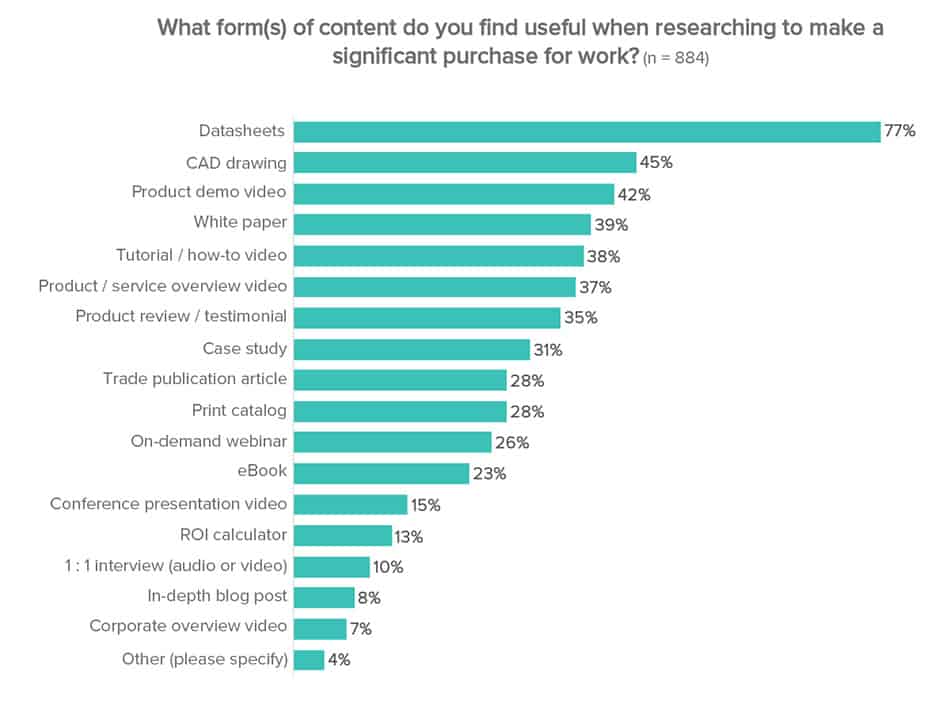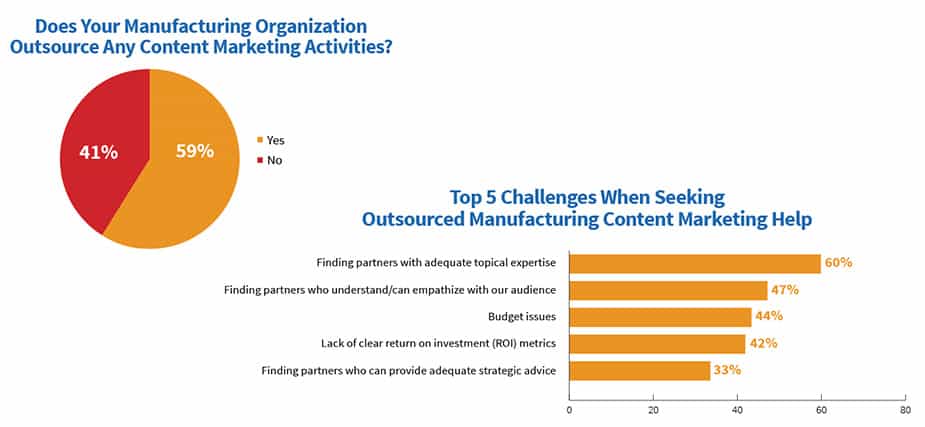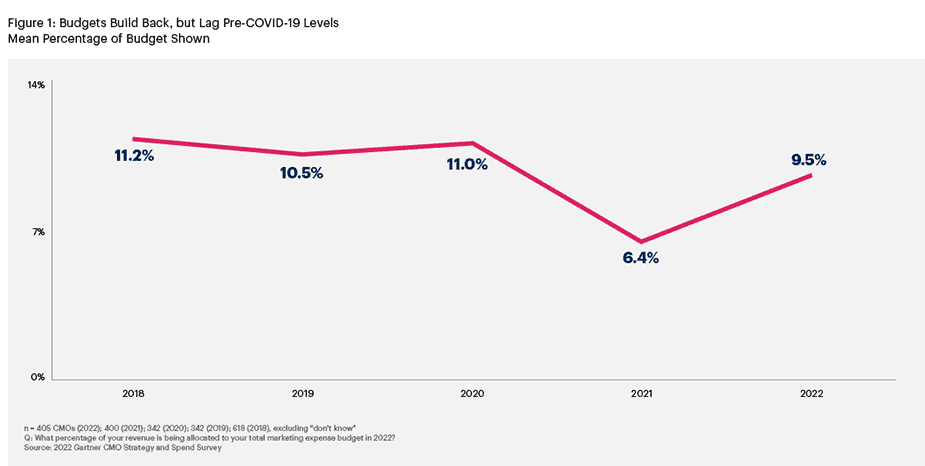What content do engineers want is probably a question you’ve asked yourself many times. An industrial website is the hub for manufacturing content marketing. It is by far the most important digital asset you own. I don’t need to repeat all the reasons for having a robust website. Yet, I’ve seen content take a backseat instead of driving an industrial website redesign.
Where do engineers go to find information for making a purchase decision?
Let’s back up a bit to see the sources engineers use to find content when making a buying decision. According to the 2022 State of Marketing to Engineers research report published by GlobalSpec and TREW Marketing, 69% of engineers go right to the source—supplier/vendor websites when researching a product or service for a business purchase.

Now that we know the number one source of information, let’s ask ourselves, what content do engineers want to see and consume? Here’s another chart from the same research study I’ve cited above.

Surprised by #1? After all, datasheets are considered product-centric and not really customer-centric content.
If you manufacture industrial components, your product specs must meet the engineer’s design specifications. Otherwise, the conversation doesn’t even start.
Now, you may be saying to yourself, “We have plenty of those.” Then let me ask you, “When was the last time you downloaded and read one of your datasheets?”
I’m not trying to be a smart-a** here. I’ve seen outdated datasheets that do not match current product specifications, added options, and features. You may lose a sales opportunity or, at the very least, damage your credibility when this happens. Do a complete audit of all your current product literature, update old ones, and create new materials if necessary.
Challenges in manufacturing content marketing
Okay, so all you need to do is create more datasheets, easy peasy lemon squeezy, right? Think again!
As a manufacturer or a distributor, your primary audience is engineers, MRO, and other industrial professionals. Creating technically accurate content that this audience will find relevant and moving them forward logically in their buying journey is a big challenge. I’ve read several research studies documenting this problem which has persisted for a few years.
It takes knowledge of the technical topic and preparing intelligent questions to ask of in-house Subject Matter Experts (SMEs) to extract the key talking points. Then, add good copywriting, editing, and SEO skills on top of that. You must go back to the SME for his/her approval before publishing any content. Rehashing product features with clever wordsmithing won’t cut it.
“Respondents said their top three content marketing challenges are creating valuable content instead of sales-oriented content (51%), overcoming the traditional marketing and sales mindset (51%), and accessing subject matter experts to create content (50%).”
That’s a direct quote from the 2022 Manufacturing Content Marketing report published by the Content Marketing Institute.
It isn’t as simple as outsourcing technical content creation either. According to the same report, 59% of respondents said their organization outsources at least one content marketing activity. Their top challenge is finding partners with adequate topical expertise (60%).

Industrial blogging—benefits and difficulties
Industrial blogging is an essential and integral part of manufacturing content marketing. If you’ve been blogging for a while, you already know blogging’s positive impact on organic SEO. That’s not all. Consistently publishing posts your audience wants to read will help win the engineer’s mindshare and build trust.
However, industrial blogging is an underutilized content strategy and has its own challenges. Read my earlier post, Using Manufacturing Blogs for Lead Generation, to learn more.
Manufacturing marketing budgets
The average marketing spend increased from 6.4% to 9.5% of company revenue across almost all industries in 2022. (Source: Gartner).

However, manufacturers tend to lag as compared to other industries. According to the latest CMO Survey, the marketing budget for manufacturers averages 4.52% of revenue and 7.65% of the total company budget as compared to 8.6% of firm revenue and 12.1% of the total budget across industries.
Marketing to engineers is not easy
I’ve worked with many in-house marketers at manufacturing companies who know marketing but struggle with engaging with engineers and technical professionals. It is not just about creating content; they need help understanding how this audience makes buying decisions.
In addition, they have difficulties formulating effective strategies for marketing to a committee of stakeholders, some of whom may never visit their websites, and the sales cycle is usually long. They want me to coach and consult with them to overcome some of these hurdles of marketing to engineers.
My presentation topic at the 2019 Content Marketing World Conference was “The Unique Challenges of Marketing to Engineers and Industrial Buyers.” You can view the video recording here.
Don’t be a victim of the “shiny new toy” syndrome
As an industrial marketer, adding a new technology stack that will make you and your team more efficient and add cool new features to your website is tempting. Nothing wrong with that goal per se. However, you probably won’t get an increase in the marketing budget if technology is the primary focus at the next planning meeting.
I recently read an interesting article by Robert Rose, the founder and chief strategy officer of The Content Advisory, the education and consulting group for The Content Marketing Institute. He explains why technology alone is not the answer, and the initial subscription cost may just be the tip of the iceberg. Read his post, “Your 2023 Planning Shouldn’t Be All About That Tech,” for valuable insights.
Content should drive your website redesign plan and the strategy for manufacturing content marketing. Don’t try to retrofit content to a design or a strategy as an afterthought.






